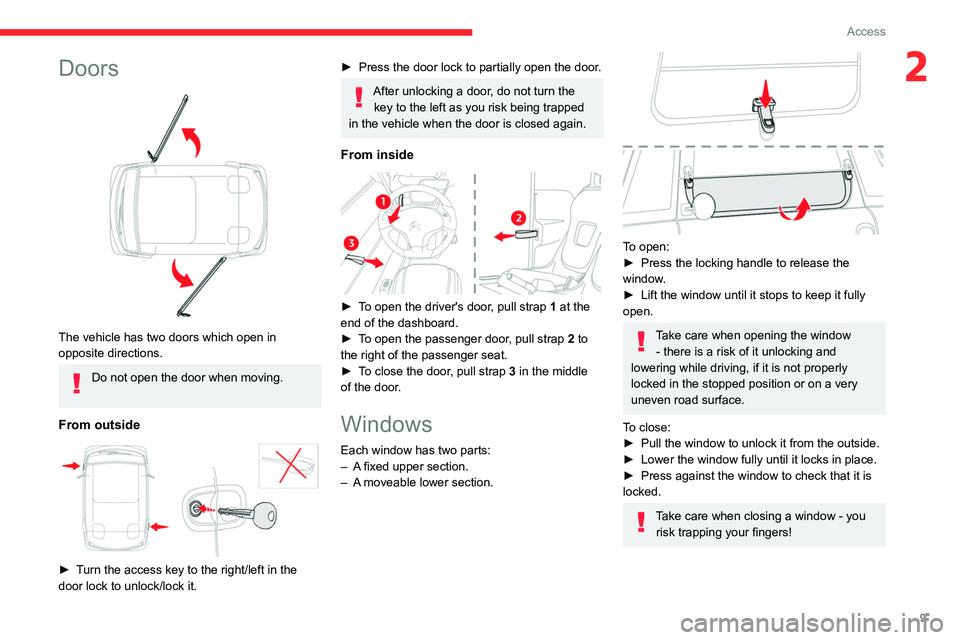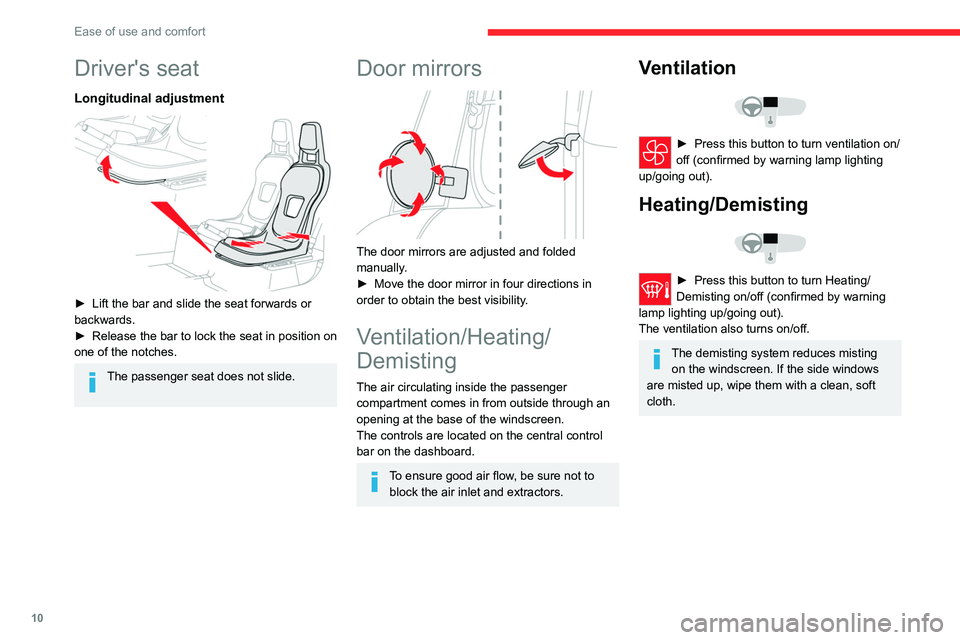2023 CITROEN AMI door lock
[x] Cancel search: door lockPage 5 of 44

3
Overview
Safety precautions -
Electric vehicles
An electric vehicle has two types of electrical
circuit:
–
vehicle traction provided by a 48 V battery
module.
–
power supply for the on-board circuit
(instrument panel, lights, ventilation/heating,
USB socket, etc.), provided by a 12
V battery
.
Precautions relating to the 48 V electrical
circuit
The components and cables which make
up the traction electrical circuit are
marked with this symbol.
The electric vehicle's charging system may become hot during use and after the
ignition is switched off.
All work on or modifications to the vehicle’s
electrical system (traction battery, cables and
other components visible from the interior or
exterior) is strictly prohibited - risk of severe
burns or electric shock (short-circuit)!
If required, call a dealer or qualified
workshop.
Precautions relating to the electrical
installation
Before any connection is made, check
that the electrical installation to be used
complies with applicable standards and is
compatible with the vehicle.
In case of doubt, contact a professional
installer.
Precautions related to vehicle cleaning
Before cleaning the vehicle, check that
the windows and doors are properly
closed.
Do not wash the vehicle while the traction
battery is being charged.
Precautions in the event of a breakdown
In the event of a complete loss of power, the
vehicle is no longer driven by the electric motor.
Quickly move the vehicle to a safe place in
accordance with all roadside safety regulations.
Immobilise the vehicle, activate the hazard
warning lamps, put on the high visibility safety
vest, leave the vehicle and find a safe place.
Call a dealer or qualified workshop as soon as
possible.
Precautions related to road accidents
In the event of an accident or impact
to the vehicle's underbody
In situations like these, the electrical circuit or
traction battery may be seriously damaged.
Stop as soon as it is safe to do so.
Apply the parking brake and switch off the
ignition.
Call a dealer or qualified workshop as soon
as possible.
In the event of exposure to a fire
Immediately exit and evacuate all
passengers from the vehicle. Never attempt
to fight the fire yourself - risk of explosion!
You must immediately contact the emergency
services, informing them that the incident
involves an electric vehicle.
Overview
1. Key for locking/unlocking doors
2. Ignition key for switching motor on/off
Page 11 of 44

9
Access
2Doors
The vehicle has two doors which open in
opposite directions.
Do not open the door when moving.
From outside
► Turn the access key to the right/left in the
door lock to unlock/lock it.
► Press the door lock to partially open the door.
After unlocking a door, do not turn the key to the left as you risk being trapped
in the vehicle when the door is closed again.
From inside
► To open the driver's door, pull strap 1 at the
end of the dashboard.
►
To open the passenger door
, pull strap 2 to
the right of the passenger seat.
►
To close the door
, pull strap 3 in the middle
of the door.
Windows
Each window has two parts:
– A fixed upper section.
– A moveable lower section.
To open:
► Press the locking handle to release the
window.
►
Lift the window until it stops to keep it fully
open.
Take care when opening the window - there is a risk of it unlocking and
lowering while driving, if it is not properly
locked in the stopped position or on a very
uneven road surface.
To close:
►
Pull the window to unlock it from the outside.
► Lower the window fully until it locks in place.
► Press against the window to check that it is
locked.
Take care when closing a window - you risk trapping your fingers!
Page 12 of 44

10
Ease of use and comfort
Driver's seat
Longitudinal adjustment
► Lift the bar and slide the seat forwards or
backwards.
►
Release the bar to lock the seat in position on
one of the notches.
The passenger seat does not slide.
Door mirrors
The door mirrors are adjusted and folded
manually.
►
Move the door mirror in four directions in
order to obtain the best visibility.
Ventilation/Heating/
Demisting
The air circulating inside the passenger
compartment comes in from outside through an
opening at the base of the windscreen.
The controls are located on the central control
bar on the dashboard.
To ensure good air flow, be sure not to block the air inlet and extractors.
Ventilation
► Press this button to turn ventilation on/
off (confirmed by warning lamp lighting
up/going out).
Heating/Demisting
► Press this button to turn Heating/
Demisting on/off (confirmed by warning
lamp lighting up/going out).
The ventilation also turns on/off.
The demisting system reduces misting on the windscreen. If the side windows
are misted up, wipe them with a clean, soft
cloth.
Page 23 of 44

21
Practical information
Charging the traction
battery
Principle
The traction battery stores the energy needed
to operate the electric motor and the vehicle's
electrical cabin components. It is discharged
during use, and must therefore be regularly
recharged. There is no need to wait for the
traction battery to fall to its reserve level before
recharging.
The traction battery's driving range varies
according to the conditions of use: speed, driving
style, heating, load carried and road surface.
The traction battery's driving range can also
vary depending on whether the age of its
components.
Like any equipment with a lithium-ion battery,
the vehicle incorporates a protection mode to
optimise the durability of its traction battery.
Depending on the charge level and temperature
of its traction battery, power may be limited to
protect the battery cells.
This protection mode affects the maximum
speed of the vehicle at low charge level (< 20%)
and at low or high battery temperature (<
+5°C
or > +45°C).
The relief of the road, such as climbing a steep
slope, also affects the maximum speed that the
vehicle can reach.
The charging cable is permanently attached to
the vehicle. It is stored in its housing located
inside the passenger door frame under the door
latch.
The single-phase AC domestic mains power socket must be standard type E/F
16
A; load is limited to 8 A.
To charge the battery, unfurl the charging cable
fully before connecting it to the domestic power
supply
.
For a full charge, follow the charging procedure
until it stops automatically.
To interrupt the charging process at any time,
disconnect the charging cable, unlock the
passenger door and store the cable in its
housing.
Charging progress is permanently displayed on
the instrument panel.
Charging progress can also be checked
via the MyCitroën App application in
combination with the connector unit (sold
separately).
For safety reasons, the motor will not
start while the charging cable is
connected.
Fully charge the traction battery at least once
a month.
Charging temperature
For vehicles manufactured before
2020/11/23, the charging is possible at
temperatures between 0°C and +50°C.
From this date, the charging is possible at
temperatures between -5°C and +50°C.
Parking in cold wheather
When the outside temperature drops
below +5°C:
–
Park the vehicle in an enclosed area.
–Maintain a charge level of the traction
battery above 50%.
Vehicle immobilised for a long period
(more than 3 weeks)
Park the vehicle in a location that is protected
from the elements and where the temperature
is between 0°C and +40°C (exposure to
extreme temperatures can damage the
traction battery).
The charging level in the traction battery must
be around 50%.
Disconnect the connector unit.
Remove the F7-50
A fuse.
Disconnect the 12 V battery.
7
Page 27 of 44

25
Practical information
7Unless there is a leak in the circuit, a drop in the
brake fluid level indicates that the brake pads
are worn.
For information on checking brake disc/
drum wear, contact a dealer or a qualified
workshop.
After washing the vehicle, moisture, or in wintry conditions, ice can form on the
brake discs and pads: braking efficiency may
be reduced. Gently dab the brakes to dry and
defrost them.
Wheels and tyres
All tyre pressures must be checked when the tyres are cold.
The pressures indicated on the tyre pressure
label are valid for "cold" tyres. If you have driven
for more than 10 minutes or more than 6 miles
(10 kilometres), add 0.3 bar (30 kPa) to the
values indicated on the label.
Under-inflation increases energy
consumption. Non-compliant tyre
pressures cause tyres to wear prematurely
and have an adverse effect on the vehicle's
road holding - risk of accident!
Driving with worn or damaged tyres reduces the
braking and road holding performance of the
vehicle. We recommended regularly checking
the condition of tyres (tread and sidewalls) and
wheel rims as well as the presence of valves. When the wear indicators no longer appear set
back from the tread, the depth of the grooves is
less than 1.6 mm; it is essential to replace the
tyres.
Using different size wheels and tyres from those
specified can affect the lifetime of tyres, wheel
rotation, ground clearance, the speedometer
reading and have an adverse effect on road
holding.
Shock absorbers
It is not easy for drivers to detect when
shock absorbers are worn. Nevertheless,
shock absorbers have a major impact on road
holding and braking performance.
For your safety and driving comfort, it is
important to have them regularly checked by a
dealer or a qualified workshop.
Changing to free-wheeling
In certain situations, you must allow the vehicle
to free-wheel (when being towed, on a rolling
road, transport by rail or sea, etc.).
►
Switch the ignition off.
► Release the parking brake.
Advice on care and maintenance
General information - Exterior
Do not wash the vehicle in full sunshine
or in extremely cold conditions.
Do not use a high pressure washer or
automatic carwash to clean the vehicle.
Use a water jet (temperature between +20°C
and +40°C).
Before starting to clean your vehicle,
remember to lock the windows and
doors.
Use a sponge and soapy water or a pH
neutral product.
Move the water jet perpendicular to the
surface to be cleaned, avoiding the door
seals.
Rinse the vehicle using demineralised water,
then gently wipe the bodywork with a clean
microfibre cloth.
Promptly clean off any marks containing
corrosive chemical substances liable to
damage the vehicle's paintwork (including
tree resin, bird droppings, insect secretions,
pollen and tar).
If justified by the environment, clean the
vehicle more frequently to remove salty
deposits (in coastal areas), soot (in industrial